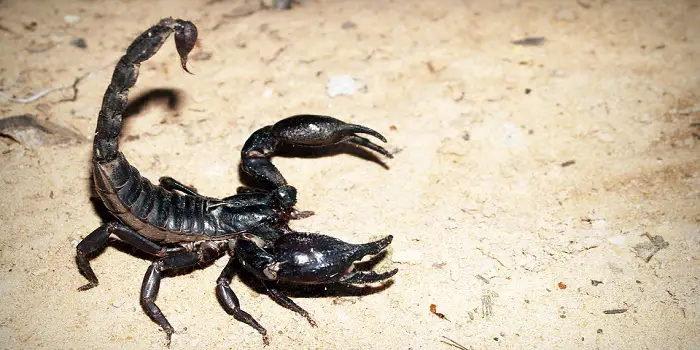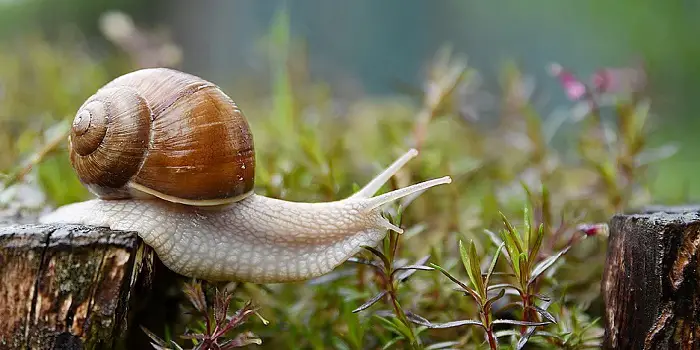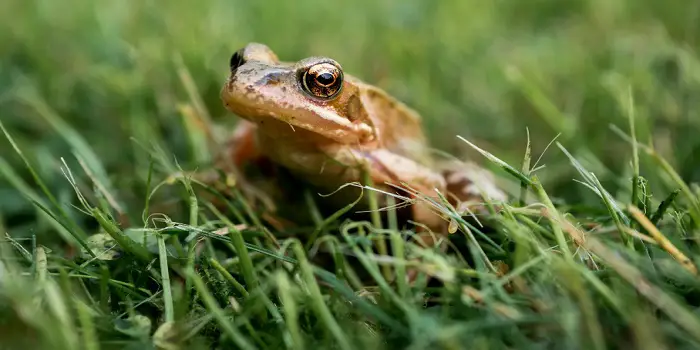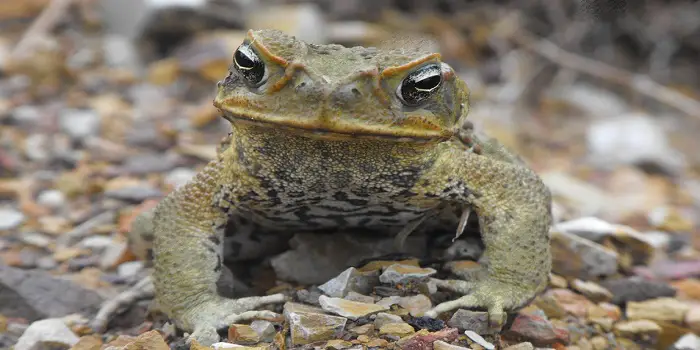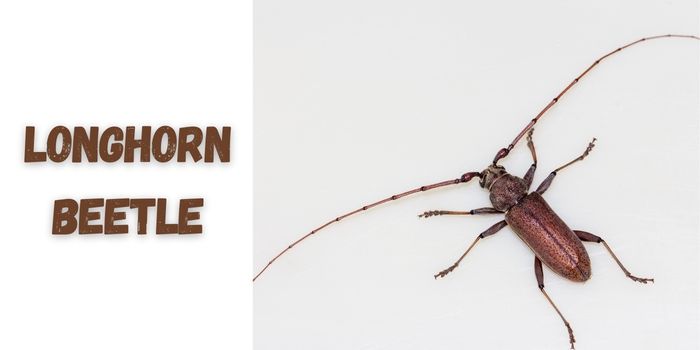
Longhorn beetles, also known as longicorns, come in over a hundred different subspecies. While there is a great variety among them, they can all be identified by their long antennae.
Longhorn beetles are not only found outdoors in wooded areas but they have also been known to invade homes through infested lumber.
Their affinity for wood creates alarmingly destructive habits, which often result in loss.
But are longhorn beetles dangerous and harmful to humans?
No, they are not!
Unlike many other beetles, they are not poisonous; they do not bite or sting.
But, although they are small, these insects can wreak havoc by tunneling through wooded areas.
A tree can die in a few years when inhabited by these pests, damaging the human economy- specifically the wood export industry.
So, knowing about them in detail and how to get rid of them is crucial to keeping your property – and the economy – safe!
Longhorn Beetles
The longhorn beetle is an exotic insect from the forests of China, Japan, and Korea.
It arrived in North America sometime in the 1990s, where it has since caused significant damage to trees due to its ability to bore into wood.
The first infestation on record occurred in 1996 on Long Island, New York, followed by another outbreak two years later near Chicago.
The longhorn beetle infestation also occurred in Toronto, Ontario, Canada, in 2003. In 2004, the same thing happened in New Jersey.
Since 2001, longhorns have been ravaging trees on European ground. It has taken 12 years to eradicate the infestation that began in 2001 and was finished in 2013 in the far north of Austria.
As a result, longhorn beetles are quite common these days in homes and properties worldwide.
Longhorn beetles usually make an irritating squeaking noise called ‘stridulation’ by forcefully moving their thorax.
This sound is a sign of irritation and usually means they are being preyed on by mammals or birds.
In summer, house longhorn beetles can fly, quickly traveling from one place to another.
What Do They Look Like?
Identifying these tiny pests is the first step to preventing them from infesting your home or business.
There are many different species of longhorn beetle, but they can all be identified by their strange long antennae and beady eyes.
Longhorn beetles have thick bodies bisected by a narrow waist and are 2-2.3 cm long. Their antennas are double the length of their bodies.
Other subspecies include the Asian longhorn beetle, which is larger since it’s an inch long and ⅝-inch wide.
Because it’s black with white dots on the lower part of its body, it’s known as the Black Long-Jawed Longhorn.
In South America, you’ll find the largest of them all: the matte black long-jawed longhorn. Some bright ones exist as well.
What Do Longhorned Beetles Eat?
The larvae of longhorn beetles feed on the wood they use for shelter. Adult ones munch on small branches and twigs.
These beetles prefer maple, willow, ash, birch, poplar, elm, and horse chestnut trees. They are also drawn to the bark of young trees, leaves, plant twigs, and short shrubbery.
Longhorn beetles consume both old and young, healthy trees while attacking them. They are also seeking out stressed trees, stumps, or logs that have been recently cut.
The larvae of Longhorned beetles create tunnels in the trees, which is how they cause damage. These tunnels are generally found on the tree’s sapwood and heartwood.
A tunnel might be half an inch broad and 4 to 6 inches long.
A pile of sawdust forms around the base of a tree or the main stem as an infestation develops on it. The grubs of longhorn beetles primarily feed on wood; they create 3/8-inch-wide holes.
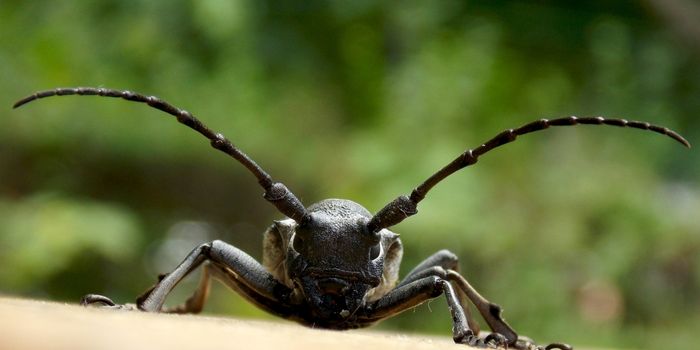
How Can You Get Rid of Longhorn Beetles?
Longhorn beetles can cause extensive damage to your property and should be removed as soon as possible.
So, if you find these pests in your home or outdoors, it’s best to call a professional exterminator.
Here are the steps and methods of control for these tiny pests.
Step 1- The first thing you must do is confirm the presence of longhorn beetles. To spot this pest, you must pay close attention to its appearance.
Step 2- This insect is most frequently observed on trees, wood, and wooden surfaces. Look for tiny holes 3/8-inch wide on a tree, wood, or wooden surface.
Larvae are likely to be visible when you crack open a piece of wood with tunnels inside.
Step 3- After conducting a tree inspection, remove the affected sections.
If longhorn beetles have spread throughout the whole tree, you must cut it down entirely. Infested regions may be burned away.
It will not only eliminate these pests but also prevent them from propagating in the future.
If some portions of the tree have not been infested, spray them with the appropriate pesticide like Dominion.
For long-term effects, soil drenching is the way to go. .1 or .2 oz of insecticide per inch of the trunk is all you need. Combine 2.5 oz of solution with 4 or 5 gallons of water.
Step 4- Make a hole in the soil around the tree trunk using a pickaxe and pour the insecticide-water mixture into it.
Step 5- After that, fill up the hole with soil to cover the mixture. In general, this solution can fill five to ten holes with four to five gallons.
You can also use traps, such as pheromone traps, to get rid of longhorn beetles. These traps are available for purchase online and at your local hardware store.
The Conclusion
Longhorn beetles are not only a nuisance, but their destructive habits often result in loss. As such, getting rid of them as soon as possible is essential.
With the aid of the steps and remedies above, you can address an infestation quickly and efficiently.
If there’s a need for expert assistance, don’t hesitate to ask for help from a professional.
Share the post "Longhorn Beetle – General Information and Prevention Guide"

Welcome to ProShieldPest.com. I am Tina Jones. I have been working as a pest removal professional in Winslow, Arizona lately. At present, I love to spend my time with my family as a retiree.
Here I share all my knowledge and experiences to help people understand better how they can stop pests at their homes without actually killing them. Hopefully, the information you will find here will help in safeguarding your home! You can check more about me here.

